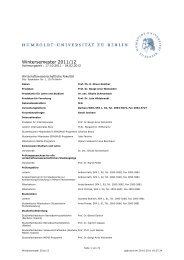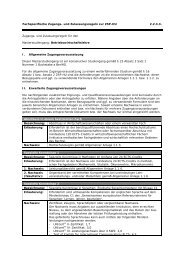Measuring the Effects of a Shock to Monetary Policy - Humboldt ...
Measuring the Effects of a Shock to Monetary Policy - Humboldt ...
Measuring the Effects of a Shock to Monetary Policy - Humboldt ...
You also want an ePaper? Increase the reach of your titles
YUMPU automatically turns print PDFs into web optimized ePapers that Google loves.
20 Bayesian FAVARs with Agnostic Identification<br />
identify <strong>the</strong> fac<strong>to</strong>rs and <strong>the</strong> loadings, separately, and fur<strong>the</strong>rmore distinguish <strong>the</strong> single<br />
fac<strong>to</strong>rs. In this <strong>the</strong>sis I follow <strong>the</strong> standard identification restrictions 18 ei<strong>the</strong>r on <strong>the</strong><br />
coefficient matrix Λ or on <strong>the</strong> fac<strong>to</strong>rs Ft employed by BBE in order <strong>to</strong> identify <strong>the</strong><br />
fac<strong>to</strong>rs and <strong>the</strong> fac<strong>to</strong>r loadings uniquely which looks like <strong>the</strong> following :<br />
Λ ′ fΛ ′ f<br />
N = I or F ′ F ′<br />
T<br />
The crucial assumption is that Yt (in our baseline model <strong>the</strong> policy instrument FFR)<br />
does not react <strong>to</strong> <strong>the</strong> X’s contemporaneously. The channels are restricted if <strong>the</strong> upper<br />
K × K block <strong>of</strong> Λ f is set <strong>to</strong> an identity matrix and <strong>the</strong> upper K × M block is set<br />
<strong>to</strong> a zero matrix. This restricts <strong>the</strong> impact <strong>of</strong> Yt on only those K variables that react<br />
contemporaneously and <strong>the</strong>refore such variables should be chosen for <strong>the</strong> respective block<br />
that do not react contemporaneously. Since fac<strong>to</strong>rs are estimated up <strong>to</strong> a rotation, <strong>the</strong><br />
choice <strong>of</strong> <strong>the</strong> K × K that is set <strong>to</strong> an identity matrix should not affect <strong>the</strong> space spanned<br />
by <strong>the</strong> estimated fac<strong>to</strong>rs 19 .<br />
For some proposes it is useful <strong>to</strong> separately identify <strong>the</strong> common shocks and <strong>the</strong> fac-<br />
<strong>to</strong>r loadings. But as only <strong>the</strong> product <strong>of</strong> <strong>the</strong> two is known, a rotation has <strong>to</strong> be chosen<br />
when one is interested in identifying <strong>the</strong> fac<strong>to</strong>rs and <strong>the</strong> loadings separately. In my case<br />
I am interested in <strong>the</strong> separate identification and in <strong>the</strong> following section I describe <strong>the</strong><br />
= I<br />
standard approach chosen by BBE that I also decided <strong>to</strong> choose.<br />
Digression on Fac<strong>to</strong>r identification In order <strong>to</strong> identify <strong>the</strong> fac<strong>to</strong>rs against rotation<br />
BBE impose <strong>the</strong> fac<strong>to</strong>r restriction F ′ F ′<br />
T = I, obtaining ˆ F = √ T ˆ Z, where Z are <strong>the</strong> first<br />
K largest eigenvec<strong>to</strong>rs sorted in descending order. In <strong>the</strong> joint estimation case <strong>the</strong> specified<br />
identification against rotation requires that <strong>the</strong> Fac<strong>to</strong>rs are identified in <strong>the</strong> following form:<br />
18 The fac<strong>to</strong>r identification should not be confused with <strong>the</strong> identification <strong>of</strong> <strong>the</strong> structural shocks <strong>of</strong><br />
e.g. monetary policy.<br />
19 see BBE [2005]




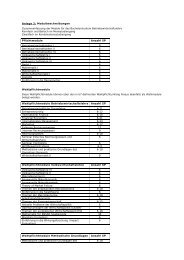

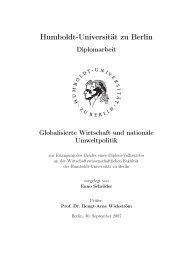
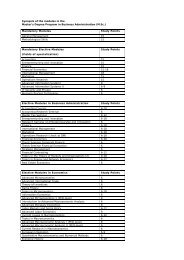
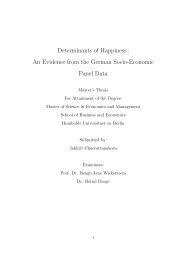
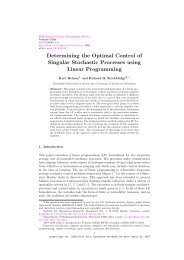
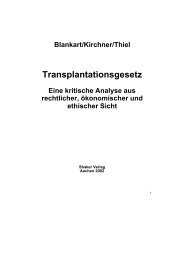


![[Text eingeben] [Text eingeben] Lebenslauf Anna-Maria Schneider](https://img.yumpu.com/16300391/1/184x260/text-eingeben-text-eingeben-lebenslauf-anna-maria-schneider.jpg?quality=85)

